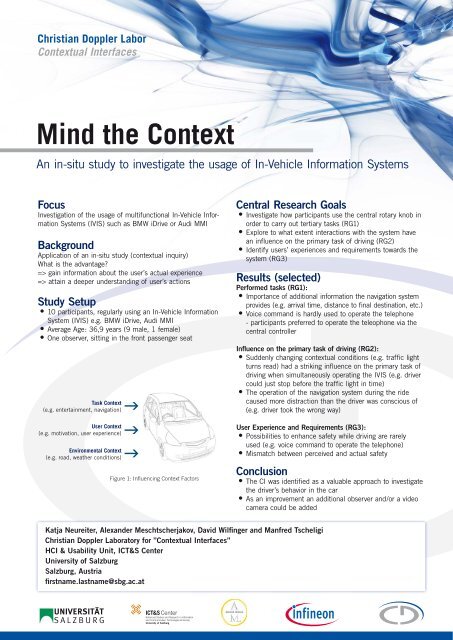Automotive User Interfaces and Interactive Vehicular Applications
Automotive User Interfaces and Interactive Vehicular Applications
Automotive User Interfaces and Interactive Vehicular Applications
Create successful ePaper yourself
Turn your PDF publications into a flip-book with our unique Google optimized e-Paper software.
Christian Doppler Labor<br />
Contextual <strong>Interfaces</strong><br />
Mind the Context<br />
An in-situ study to investigate the usage of In-Vehicle Information Systems<br />
Focus<br />
Investigation of the usage of multifunctional In-Vehicle Information<br />
Systems (IVIS) such as BMW iDrive or Audi MMI<br />
Background<br />
Application of an in-situ study (contextual inquiry)<br />
What is the advantage?<br />
=> gain information about the user’s actual experience<br />
=> attain a deeper underst<strong>and</strong>ing of user’s actions<br />
Study Setup<br />
� 10 participants, regularly using an In-Vehicle Information<br />
System (IVIS) e.g. BMW iDrive, Audi MMI<br />
� Average Age: 36,9 years (9 male, 1 female)<br />
� One observer, sitting in the front passenger seat<br />
Task Context<br />
(e.g. entertainment, navigation)<br />
<strong>User</strong> Context<br />
(e.g. motivation, user experience)<br />
Environmental Context<br />
(e.g. road, weather conditions)<br />
�<br />
�<br />
�<br />
Figure 1: Influencing Context Factors<br />
Katja Neureiter, Alex<strong>and</strong>er Meschtscherjakov, David Wilfinger <strong>and</strong> Manfred Tscheligi<br />
Christian Doppler Laboratory for ”Contextual <strong>Interfaces</strong>”<br />
HCI & Usability Unit, ICT&S Center<br />
University of Salzburg<br />
Salzburg, Austria<br />
firstname.lastname@sbg.ac.at<br />
Central Research Goals<br />
� Investigate how participants use the central rotary knob in<br />
order to carry out tertiary tasks (RG1)<br />
� Explore to what extent interactions with the system have<br />
an influence on the primary task of driving (RG2)<br />
� Identify users’ experiences <strong>and</strong> requirements towards the<br />
system (RG3)<br />
Results (selected)<br />
Performed tasks (RG1):<br />
� Importance of additional information the navigation system<br />
provides (e.g. arrival time, distance to final destination, etc.)<br />
� Voice comm<strong>and</strong> is hardly used to operate the telephone<br />
- participants preferred to operate the teleophone via the<br />
central controller<br />
Influence on the primary task of driving (RG2):<br />
� Suddenly changing contextual conditions (e.g. traffic light<br />
turns read) had a striking influence on the primary task of<br />
driving when simultaneously operating the IVIS (e.g. driver<br />
could just stop before the traffic light in time)<br />
� The operation of the navigation system during the ride<br />
caused more distraction than the driver was conscious of<br />
(e.g. driver took the wrong way)<br />
<strong>User</strong> Experience <strong>and</strong> Requirements (RG3):<br />
� Possibilities to enhance safety while driving are rarely<br />
used (e.g. voice comm<strong>and</strong> to operate the telephone)<br />
� Mismatch between perceived <strong>and</strong> actual safety<br />
Conclusion<br />
� The CI was identified as a valuable approach to investigate<br />
the driver’s behavior in the car<br />
� As an improvement an additional observer <strong>and</strong>/or a video<br />
camera could be added





